They’re the 10 horses and riders from which the Olympic team will be named.
Laura Kraut said that “you always expect the unexpected in these trials,” and that quote rang true through the U.S. Equestrian Federation Olympic Show Jumping Selection Trials, Feb. 28-March 9 in Wellington, Fla.
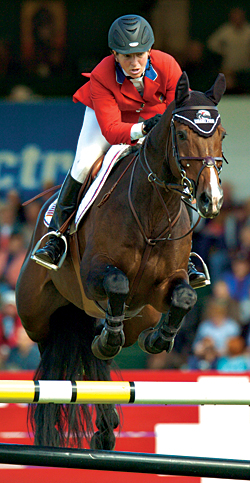
The crucible of five rounds of tough jumping resulted in a short list of 10 horses and riders from which U.S. Equestrian Federation selectors will choose the show jumping team for the 2008 Olympics in Hong Kong. The short list is a fascinating mix of veterans with medals to their names, up-and-coming horses and young riders with new scarlet USEF jackets in their coat bags.
Before the trials began, the USEF Ad Hoc Committee on Selection named Beezie Madden and Authentic and McLain Ward on Sapphire to the short list, exercising two of their four discretionary choices. Ward and Madden have been the backbone of the U.S. teams for the past four years, helping to win team gold at the 2004 Athens Olympics and team silver at the 2006 World Equestrian Games (Germany).
After the first two rounds of the trials, the selection committee announced that Jeffery Welles and Armani would join the short list. Welles and Armani were the alternates for the 2006 WEG team and jumped clear in Rounds 1 and 2 of the trials.
At the start of Round 1, 49 horses and riders had Olympic aspirations. But just 20 competed in all five rounds.
Big Jumps
Round 1 was held Feb. 28 under the lights of the Internationale Arena at the Palm Beach International Equestrian Center. Eight horses jumped clear that night, including Kraut and Cedric. Built by German course designer Christa Heibach, the track was big but not overly technical.
Heibach designed Round 2 as well, held within the $100,000 Zada Enterprises LLC Masters Cup CSI-W on March 2. Heibach upped the ante, building a scopey, technical course that included a tough bending line to the open water and a triple combination of triple bar-oxer-vertical. Only three of the selection trial horses jumped clean—Will Simpson on Carlsson vom Dach, who won the class, Nicole Shahinian-Simpson on SRF Dragonfly and Armani and Welles.
| The European Tours
TOUR 1 Charlie Jayne/Urbanus TOUR 2 Laura Kraut/Cedric |
Round 3 went back under the lights on March 5, and course designer Jose “Pepe” Gamarra built a somewhat milder test under a speed-round format and didn’t use the open water. Simpson won the round on Carlsson, Kraut and Cedric added a time fault, and Shahinian-Simpson, Charlie Jayne on Urbanus and Kate Levy on Vent du Nord jumped three of the five clear rounds that night.
Thunderstorms moved Round 4 from under the lights on March 5 to the bright sun on March 6, and Gamarra put up massive jumps and used a technical line of a liverpool oxer, six tight strides to a triple combination. A vertical-oxer-vertical combination, it caused many rails. Then, in a tight four strides, was a 1.60-meter airy vertical, which also broke a few hearts. Simpson and Chris Kappler on VDL Oranta were the only clear rounds of the day.
Making A List
The grand finale, Round 5, was on March 9, within the $150,000 CN U.S. Open. Gamarra built big and used a tough line early in the course. The third jump—a vertical, was set in just five or six bending strides before the open water. Riders also had a short, bending approach to the scopey vertical-oxer-oxer triple combination.
Shahinian-Simpson jumped the only clear round of the selection trial riders with SRF Dragonfly, and the drama increased as Simpson and Carlsson vom Dach—tied for second in the trials at that point—didn’t jump.
In the end, Kraut and Cedric sat atop the standings, with Shahinian-Simpson second with SRF Dragonfly and Anne Kursinski third on Champ 163. Charlie Jayne claimed fourth on Urbanus, and Kursinski’s second mount, Roxana 112, tied for fifth with Kate Levy on Vent du Nord and Christine McCrea on Vegas.
The selection committee chose to add Simpson and Carlsson vom Dach to the short list, although they didn’t complete Round 5 of the trials, so there was room for the top six on the short list.
Selection trial procedures broke the tie for fifth and put Roxana and Kursinski and Levy on Vent du Nord on the list, making McCrea and Vegas the first alternate.
Those 10 horse-rider combinations were divided into two teams that will travel to Europe and show at Super League shows (see sidebar). After the Aachen CSIO (Germany) in July, the selection committee will name the five horses and riders who will compete at the 2008 Olympics in Hong Kong.
Beezie Madden/Authentic, McLain Ward/Sapphire & Jeffery Welles/Armani
Madden, 44, Cazenovia, N.Y., and Authentic have established themselves as the anchor of the U.S. team. They won the $200,000 Budweiser American Invitational (Fla.) and the $330,067 Rolex Grand Prix of Aachen (Germany) in 2007.
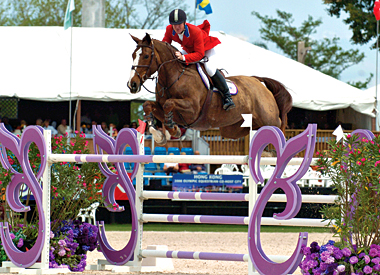 Ward, Brewster, N.Y., and Sapphire were the top-placed U.S. combination at the 2007 FEI Rolex World Cup Final (Nev.), in eighth. Sapphire turned in a clean round for the U.S. team’s win in the $75,000 CN Nations Cup on March 7. “We have the luxury of the bye to the short list, so I’m trying to take it easy, jump a class here and there, and keep her fresh and healthy. In the summer, we’ll put our nose to the grindstone,” Ward, 32, said.
Ward, Brewster, N.Y., and Sapphire were the top-placed U.S. combination at the 2007 FEI Rolex World Cup Final (Nev.), in eighth. Sapphire turned in a clean round for the U.S. team’s win in the $75,000 CN Nations Cup on March 7. “We have the luxury of the bye to the short list, so I’m trying to take it easy, jump a class here and there, and keep her fresh and healthy. In the summer, we’ll put our nose to the grindstone,” Ward, 32, said.
Armani didn’t show in 2007, taking the time to recover from minor elective leg surgery. But two clear rounds over Rounds 1 and 2 prompted the selectors to name him to the short list. “He feels better than ever,” Welles said. “He wasn’t really lame, but he was favoring that leg. It was basically more preventative for the future. It was a risk to do the surgery, but it was a good year for him to have off. I wanted to have him at his best this year.”
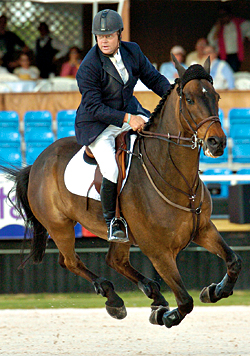
Welles, 45, Brewster, N.Y., plans to aim Armani for the $200,000 Budweiser American Invitational on April 5. He was relieved to not have to complete the trials. “It was a lot of jumping for these horses to go through, and just to see them every day keep trying and trying was very impressive,” he said.
Will Simpson/Carlsson vom Dach
After picking up 12 faults in Round 1, Simpson and Carlsson vom Dach jumped three consecutive clear rounds to work their way up to a tie for second in the standings. But before Round 5, disaster struck.
“There was a thunderstorm, and we speculate that Carlsson had some kind of trauma in his stall,” Simpson said.
“We don’t think he got cast; we think he flipped over and hit his neck, his withers, and probably actually knocked himself out. When we got there at 6 a.m., he was almost neurological—backing up and almost falling down.”
With intensive chiropractic and acupuncture treatments, Carlsson was much improved and sound by the start of Round 5, suffering just limited mobility in his neck.
But Simpson decided not to jump because Carlsson was exhausted. “He had no energy and he wasn’t ready to jump a championship course,” he said. The horse passed the veterinary inspection that followed Round 5, and the selectors decided to include him on the short list.
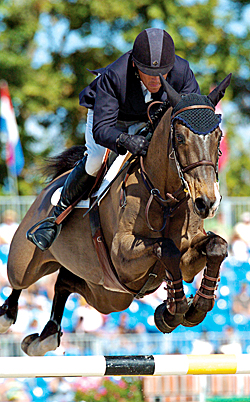 For Simpson, 48, Thousand Oaks, Calif., competing at the Olympics would be “the pot of gold at the end of a rainbow of a lifetime of work,” he said. “For me to have a horse that’s this good, at this time, is already the whole cake, and to make the team would be the icing on the cake.”
For Simpson, 48, Thousand Oaks, Calif., competing at the Olympics would be “the pot of gold at the end of a rainbow of a lifetime of work,” he said. “For me to have a horse that’s this good, at this time, is already the whole cake, and to make the team would be the icing on the cake.”
ADVERTISEMENT
A veteran of FEI World Cup Finals and consistent grand prix winner in California, Simpson has never ridden on a championship team.
When German horse dealer Gilbert Boeckmann called Simpson last summer and told him he had a horse that he thought might suit Simpson, there weren’t many signs that Carlsson would be an Olympic candidate.
“I had no idea he’d be this good until about the third month I’d had him,” Simpson said. “I thought he’d be a good horse, but then he showed me some things that were incredible. He’s not a really big horse—he’s 16.1—or a flashy horse. But he’s extremely scopey, extremely careful and extremely fast. He’s got wings; he’s like a bird. It’s an incredible feeling.”
| About The Short-Listed Horses
Authentic, 13, Dutch Warmblood, Guidam—Gerlinda Ster, Katell, owned by Abigail Wexner. Sapphire, 13, Belgian Warmblood, Darco—Idjaz C, Hedjaz, owned by Blue Chip Bloodstock and McLain Ward. Armani, 13, Dutch Warmblood, Guidam—Fzostara, owned by Kimmel Yeager Equine LLC. Carlsson vom Dach, 11, Holsteiner, Cassini I De—Gelsa De, owned by El Campeon Farm. Cedric, 10, Belgian Warmblood, breeding unknown, owned by Happy Hill Farm. SRF Dragonfly, 11, Belgian Warmblood, Landwind—Monika, owned by Silver Raven Farm. Champ 163, 9, breeding unknown, owned by Legacy Stable. Urbanus, 11, Belgian Warmblood, Heartbreaker—L’etoile Filante, Ramiro, owned by Alex R. Jayne. Roxana 112, 14, Hessen, Rodgau—Loret, owned by Scott Hakim. Vent du Nord, 10, Belgian Warmblood, Canadiannver—Zwichta, Quidam de Revel, owned by Kate Levy LLC. |
Simpson blamed their 12 faults in Round 1 on himself.
“When I got here, I was riding my horse a couple of times a day because I didn’t have anything else to do with only two horses here,” he said. “But then I looked at him, and he looked empty—I thought I was doing too much. So, for the first trial, he just hand-walked during the day and I tried to freshen him up. At 9:30 at night, ice-cold weather under the lights, he freshened up way too much. He was a great horse to go around, but he should have said, ‘No way.’ ”
For the remaining trials, Simpson reverted to his usual pre-class routine of flatting Carlsson and jumping a few jumps, and they returned to jumping clean rounds.
Laura Kraut/Cedric
After Round 1, Kraut joked that “Cedric is 10, going on 6.” The gray gelding has a huge jump but has played second fiddle to Kraut’s experienced international mounts, Anthem and Miss Independent.
“He’s been an amazing horse from the beginning. Just when you think he might throw the towel in, he digs deep and figures things out,” she said.
Kraut, 42, Wellington, Fla., has had Cedric since he was 6. “This is the first time he’s jumped so many 1.60-meter rounds in a row. He actually hasn’t jumped that many of them. I protected him all last year and made him my second horse, so I’d say this is about his eighth or ninth effort of jumping 1.60 meters. But he’s found his jump.”
Cedric’s exuberant jumping keeps the crowd on the edge of their seats.
“He’s always jumped 1.80 meters over every jump,” Kraut said. The bouncy gray gelding is known for his enormous leaps over the open water jumps.
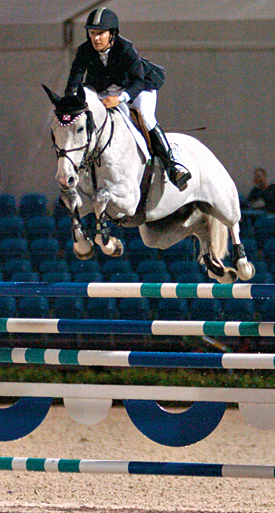
Cedric had one rail down over the five rounds, in Round 4. “The one rail he had was for sure my fault,” Kraut said. “He’s just an amazing animal. I think he knows that he’s not supposed to knock any rails down. And if I stay out of his way, he manages not to.”
Picking up 1 time fault in each of Rounds 2, 3 and 5 brought their fault total to 7 and put them atop the trials standings.
“I’ve spent the last two summers with him in Europe, and last summer he won a big class in Athens [Greece] and a grand prix in Hachenburg, Germany. He was second in the big classes in Brussels [Belgium] and Dublin [Ireland]. He’s been around a lot. He’s almost had more mileage in Europe than here,” Kraut said.
While she’s thrilled that Cedric rose to the challenge of the trials, Kraut will wait until the summer to think about the Olympics.
“I don’t know if he’s an Olympic horse, but he’s grown up a lot through this experience,” she said. “I don’t have my heart set on going to Hong Kong. If he’s not right and not the one to go then I definitely don’t want to go. I’ve been there, and you don’t want to go on a wing and a prayer. You want to go thinking you’re going to do well. If he continues along the lines that he’s been doing, then I would feel confident, but it’s hard to say.”
Miss Independent, whom Kraut rode on the silver-medal team at the 2006 WEG, was on her way back from an injury and didn’t start the trials. Anthem, 17, was in the running for a spot after Round 2, tied for third with 4 faults, but after 8 faults in Round 3, Kraut pulled him from the trials.
“He jumped three great rounds, and that horse has proven himself over and over again,” she said.
Nicole Shahinian-Simpson/SRF Dragonfly
If you’d asked Shahinian-Simpson about SRF Dragonfly when she first took over the ride in November, the Olympics probably wouldn’t have been a goal. But the flashy chestnut mare surprised Shahinian-Simpson by jumping three clear rounds in the trials, finishing second and making the short list.
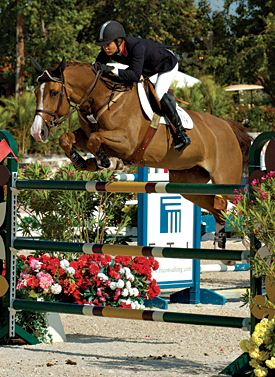
“It’s kind of interesting because this was kind of not really part of her plan. I started her [at the Winter Equestrian Festival] in some of the smaller classes and the owners really believe in her, so they wanted to do this. I said, ‘We’ll just start and see how it goes.’ So that’s how we’ve ended up here. I have to say I’m just thrilled with her. She’s really risen to the occasion. Everything that’s been asked of her, she keeps doing.”
Owner Katie Polk had ridden Dragonfly in the amateur-owner jumper division, and Leslie Steele had shown her in some grand prix classes in California. When Polk moved to New York City for her career, Shahinian-Simpson got the ride on Dragonfly.
ADVERTISEMENT
“Her flatwork and rideability have gotten fantastic,” said Shahinian-Simpson. “She loves her job, and she’s thrilled me with her effort and her confidence in herself. She’s really grown through the trials. This is a lot for a horse to jump so many big rounds without a break of dropping down for a class or two. She comes back in and doesn’t think twice about it.”
A member of the 2002 WEG team, Shahinian-Simpson, 33, now rides and trains out of Wellington, Fla.
Anne Kursinski/Champ 163 & Roxana 112
Kursinski, 53, Frenchtown, N.J., is no stranger to the Olympic challenge—she has team silver medals from the 1988 and 1996 Games and rode on the 1992 Olympic team as well.
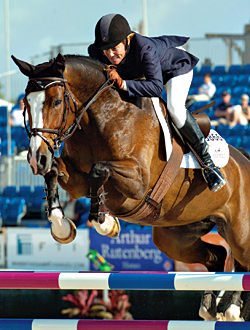 But now she’s close to another team on a horse that’s a bit of a stranger to her. Kursinski only showed Champ in four classes at WEF before the trials started, since he’d just gotten out of quarantine in January.
But now she’s close to another team on a horse that’s a bit of a stranger to her. Kursinski only showed Champ in four classes at WEF before the trials started, since he’d just gotten out of quarantine in January.
“I’m very excited about Champ. I wasn’t even sure if I was going to enter him for the trials because he’s just 9, but then he had 4 faults in the grand prix before them, and George [Morris] and I said, ‘Well, let’s see what happens.’ And I think that he’s proven that he’s a championship horse. We just need to get to know each other better,” she said.
After starting with 9 faults in Round 1, Champ improved steadily, with no more than one rail in each of the other rounds and jumping clean but with 1 time fault in Round 3.
“Champ is much less green now than he was at the start of the trials,” Kursinski said, smiling.
In 2006, Kursinski was close to making the WEG team with Roxana but conceded that it might have been too early for the mare to face an international championship. This year might be better.
“I think it’s a great time for her to go to Europe. Is she ready for the Olympics? I won’t know until we’re in Europe. I think the trials were a test every single day with questions that showed we’re ready to find out. Roxana was great and consistent,” she said.
Charlie Jayne/Urbanus
Charlie Jayne took a three-month vacation from showing that ended just two weeks before the trials, serving a suspension from the Fédération Equestre Internationale for a medication violation stemming from a catch-ride (see Feb. 22, p. 112). “It was a little bit down to the wire, and all the stars had to line up to make it work, but it worked,” Jayne said.
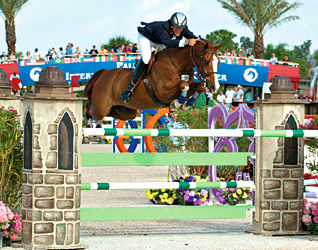
Jayne, 21, Elgin, Ill., started Thomas Edison and Urbanus in the trials and ended up fourth on Urbanus with 24 total faults and 13th with Thomas Edison with 36 faults.
“I was thrilled with them. The first day I had a little mistake on Urbanus down the last line. I might have gotten a little bit nervous and had two of the three jumps down. After that, I had four more consistent rounds with ‘Ernie.’ He couldn’t have tried any harder for me. The second week, he got even better. He’s one of the most consistent horses I’ve ever had,” Jayne said.
The time off made Jayne’s preparation a little different. Instead of showing, he spent his time in lessons with his father, Alex, and Norman Dello Joio.
“But it turns out that my ‘vacation’ wasn’t the end of the world because I went back to the basics and focused on my riding,” he said. “I did a lot of flatwork and worked on body control and getting my horses to come up beneath me, keeping my horse with me at the ends of the ring. And I did have some of the freshest horses in the trials.”
Jayne and his father found Urbanus in Belgium in the fall of 2005. “We tried about 60 horses, and we were on the 15th horse of the day. It was 10:30 p.m., it was raining and we were all tired. He was the last horse we saw, and I tried him in the smallest indoor ring I’ve ever ridden in,” Jayne recalled.
“The jump standards were metal poles and the rails were sticks, but he jumped like a freak. We bought him,” said Jayne.
After some time in the junior/amateur-owner ranks, Jayne and Urbanus moved to grand prix in 2006. Consistent placings in 2007 earned Jayne his USEF debut on the winning Nations Cup team at the Buenos Aries CSIO (Argentina) in November 2007.
“In the past year, Urbanus has become really world-class. He’s so determined in the ring to get over the jumps. In the schooling ring, he can get a bit nervous and a little crazy, but once he walks into the ring, he walks in like he owns the place,” Jayne said. “I love being on teams. Being on the Nations Cup team with all those great riders is going to be a great experience. I can’t wait to prove myself in Europe.”
Kate Levy Has An Entirely New Outlook On Life Six months ago, Kate Levy wasn’t thinking about the Olympic selection trials—she was concentrating on staying alive.
Levy, 27, Wellington, Fla., had been crushed when the horse she was riding spooked, reared and fell on her on Aug. 16, 2007. Her pelvis was broken in multiple places, her femur was in eight pieces and she suffered a broken hip, tailbone and pubic bone. Her ribs were also broken, and she had a ruptured spleen. She required eight blood transfusions.
“I was stuck in a hospital bed for a long time,” Levy said. “For a while, just to make it alive was the first concern. Then, I had to think about walking again. Riding again was sort of blurry. We didn’t know if it would ever be possible. I really didn’t know if I’d ever want to ride again.”
But Levy started walking without crutches at Christmas and got back in the saddle in mid-January. “I give a huge thanks to my team, Alex Ronin and Delphine Collett,” she said. “They’ve been behind me and did a great job caring for my horses and keeping them fit while I was unable to ride.”
In a Herculean effort, Levy got herself in shape to start the Olympic selection trials and rode Vent du Nord to consistent rounds to finish tied for fifth in the trials standings.
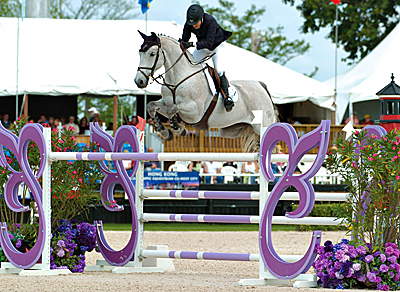 “Before my accident I really had my heart set on the trials. We were really practicing the water, which was a problem for my horse,” Levy said. “He had been jumping the water beautifully all summer. When I started riding again, that was a concern of mine, but he felt great. He hadn’t jumped at all, but he was really fit and feeling good. Getting ready for the trials was really a rollercoaster. I didn’t know if I’d be ready. At the last minute we decided to give it a shot.”
“Before my accident I really had my heart set on the trials. We were really practicing the water, which was a problem for my horse,” Levy said. “He had been jumping the water beautifully all summer. When I started riding again, that was a concern of mine, but he felt great. He hadn’t jumped at all, but he was really fit and feeling good. Getting ready for the trials was really a rollercoaster. I didn’t know if I’d be ready. At the last minute we decided to give it a shot.”
Riding wasn’t easy for Levy. “It definitely hurts. I’m not back to normal. I’m riding minimally. I used to do everything to the max—I rode as much as I could. Now I’m kind of the opposite because I have a lot of pain in my leg. It’s not strong enough, and my hips are painful. Physically, the trials were really hard on me. I’m going to take the time before going to Europe to get physically better and stronger,” she said.
The key to her success in the trials was the generosity of Vent du Nord and their strong bond. “He really takes care of his mom, especially considering he’s not even got half a rider on him. He knows his job, and he’s great,” she said. “He’s so athletic and strong; he can jump anything. I thought that, despite me, my horse deserved a chance to try and go to the Olympics.”
Levy got Vent du Nord five years ago as a green 5-year-old in part of a trade deal she worked out. “He wasn’t really my first choice because he was very difficult to ride,” she recalled. “He was just thrown in at the end, which is funny to think about now. All the other horses I got in the deal got sold pretty quickly. But I think he’s grown to be a family member, and he just keeps getting better and better.”
Headed into the selection trials, Levy had a whole new attitude. “I think I learned a lot from having the accident. Before, I had my goals, and I was easily disappointed if things weren’t going to plan. I would have every day of my life planned out. This time around, I’ve realized that you can’t plan everything and that you have to take things as they come. At any given moment, everything can change,” she said.
“Before Round 1, I hadn’t jumped a course like that in a really long time, so I have to say that I rode nervous
but my horse was wonderful,” Levy said. “In the second trial, the course was enormous, but I had all the confidence in him and his scope. The third trial, I felt pretty confident, and he was great.
But I have to say, in the fourth and fifth trials, he started to get quite keen. I think he’d jumped so many big rounds that he was really confident and full of himself. He got very strong, which he doesn’t normally do, and I ended up with two rails basically from rideability issues. He was thinking he was Superman.”
Molly Sorge














